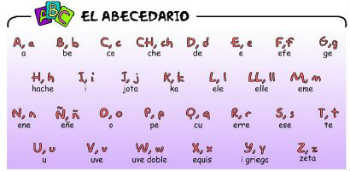Spanish Alphabet Pronunciation
The Spanish Alphabet
The image below shows the traditional Spanish alphabet which consisted of 30 letters. The traditional Spanish alphabet was similar to the English alphabet, with the addition of four letters; ch, ll,ñ, and rr. The NEW Spanish Alphabet is the English alphabet with the addition of one letter: ñ, for a total of 27 letters. The lessons below will first teach you the "name" of each letter of the Spanish alphabet. Then you will learn how to pronounce the letters of the Spanish alphabet when they are used to form Spanish words. Spanish letters may have a different sound depending upon their location in the Spanish word. Spanish uses the Latin alphabet, with the addition of the letter ñ. Spanish vowels can take an acute accent. Spanish alphabet pronunciation may be problematic. Beginning Spanish students often confuse the Spanish and English vowels a, e, i. The Spanish and English consonants h, j, r, y will also cause trouble, due to the fact that they have very different names in Spanish.

Spanish Alphabet Pronunciation
English speaking students who study Spanish will usually have problems with Spanish punctuation. They will inevitably leave off the punctuation at the beginning of the sentence. It must be remembered that questions or exclamations are punctuated as follows: ¿What is your name? or ¡What a goal! Punctuation of direct speech may also be a problem for English speaking students because quotation marks are NOT used in Spanish. If you ever feel that you would like to try a private online Spanish tutor to practice the pronunciation of the Spanish alphabet, please try the experienced Spanish tutors at NuLengua.com
Spanish alphabet pronunciation can be difficult. The vowel sounds and sentence stress used in Spanish is significantly different from that of English. These differences are serious challenges to study who study Spanish. English has 12 pure vowel sounds and 8 diphthongs and the length of the vowel sound plays an important role. This contrasts with Spanish which has 5 pure vowels and 5 diphthongs. The length of the Spanish vowel sound is not significant in distinguishing between Spanish words. Of course, the easiest way to improve your Spanish alphabet pronunciation is to play a few of our 1,000 Spanish alphabet games!
Pronunciation of Spanish Vowels and Consonants
Unlike English, each Spanish vowel has one pronunciation (short and crisp), regardless of its position in a word. Compare the vowel sounds in the following Spanish/English pairs: [banana/banana] and [monopolio/monopoly].
The following Spanish consonants require special attention [g, h, j, s, z] because their pronunciations can differ significantly from English. Compare these sets of words [gesto/gesture, Japan/Japón, hotel/hotel, miseria/misery, zona/zone].
Spanish does not create "mushy" sounds out of consonant-vowel combinations [pasión/'passion', casual/'casual', temperatura/'temperature', computadora/'computer'].
The -u- in the combinations -qu- and -gu- is not pronounced; its function is to maintain a hard c/g sound [quieto/'quiet (calm)' // guerra = 'war'. Note, however, that the ü is pronounced as a "w" [vergüenza = ver-GWEN-sa = 'shame/embarrassment'].
Pronunciation of the Spanish Alphabet
Spelling
Spanish only permits two double consonants -cc- [lección/lesson, and -nn- [innato/'innate']. The Spanish rr [carro/'car'] and ll [llorar/'to cry'] are distinct letters of the alphabet.
Spanish does not capitalize certain forms [el lunes/Monday, marzo/March, español/Spanish, el señor García/Mr. Garcia, Los de abajo = The Underdogs]. Note, however, that titles are capitalized in direct address. [¿Cómo está, Señor García? = 'How are you, Mr. Garcia?'].
Vowels a/o/u vs. e/i affect the pronunciation/spelling of preceding consonants c/g [cine/'cinema' vs. carro/'car', and gitano/'gypsy' vs. gasolina/'gasoline']. To conserve a hard c and g, spelling changes to qu and gu, respectively as in [tocar = 'play (music)' Toqué la guitarra. = 'I played the guitar.', and jugar = play (game) Jugué al tenis. = 'I played tenis.']. The letter z only appears before the vowels a/o/u in Spanish. It must change to c if the following vowel changes [comenzar = 'begin' Comencé a llorar = 'I began to cry.'].
Syllables/Word Stress
The two languages divide words differently. Spanish attempts to begin each syllable with a consonant and the weak vowels u/i (unless accented) form a single syllable with a neighboring vowel. All of this is seen in [so-cio-lo-gí-a = 'soc-i-o-lo-gy'].
Spanish and English stress patterns differ [generoso/'generous']. Spanish words ending in a vowel or the consonants -n or -s carry natural stress on the next-to-last syllable (hablo = 'I speak', hablas = 'you speak', hablan = 'they speak'). If the word ends in anything else (another consonant), it carries natural stress on the last syllable [hablar = 'to speak'].
Accent Marks
There are two basic rules for using the written accent. First, if a Spanish word violates one of the natural stress rules above, a written accent is required [hablé = 'I spoke', ends in a vowel. / el fósil = 'fossil', ends in a consonant]. Secondly, the written accent distinguishes a series of one-syllable words [el = 'the' vs. él = 'he', si = 'if', vs. sí = 'yes', etc.].
The addition of a syllable to a word affects the written accent according to the word stress rules above [la nación las naciones = 'nations' // ¡Coma los vegetales! = 'Eat the vegetables!' ¡Cómalos! = 'Eat them!']
Popular Phrase: learning spanish | Spanish Verb Conjugations | Conjugated Verb: conversar - to talk, converse; to tell, relate [ click for full conjugation ]
